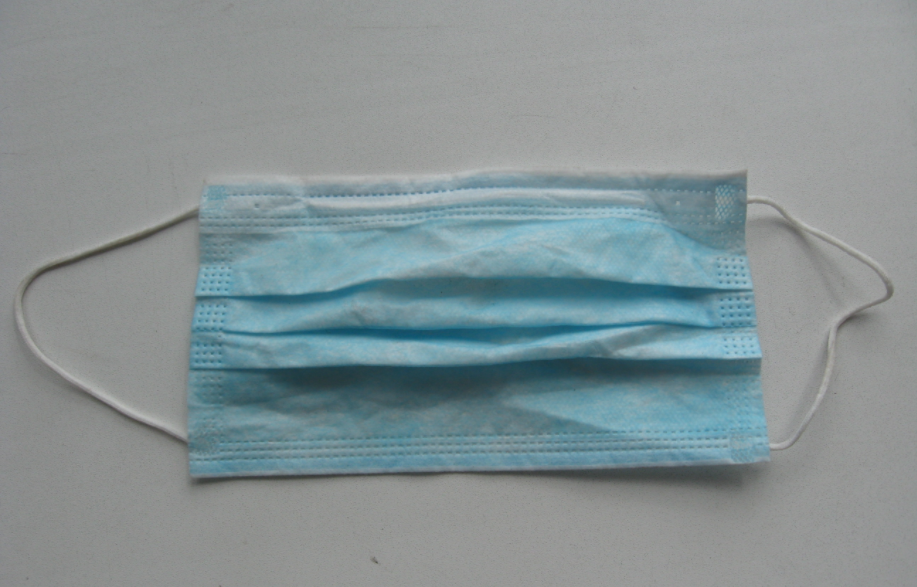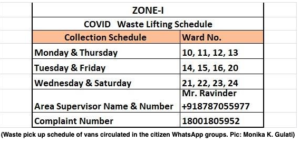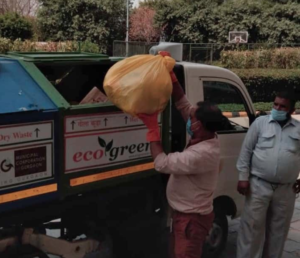
Gurugram’s population of almost 9 lakhs has one Common Biomedical Waste Treatment Facility (CBWTF) for its collection, transportation, and treatment – authorized by the Haryana State Pollution Control Board. In the wake of the pandemic, this CBWTF has faced unprecedented demand from the residential sector to collect and process their COVID-19 biomedical waste as a part of its service.
The agency, RWAs and the Municipal Corporation of Gurugram (MCG) have been grappling with many challenges, as they attempt to streamline and ensure safe, regular collection and treatment of contaminated biomedical waste from quarantine homes.
Post pandemic, in Gurugram, new collection routes to collect BMW from quarantine homes were laid out. The CBWTF operator, M/s Vulcan Waste Management Co. (recently renamed Biotech Waste Ltd.) started domestic collection, since most of the clinics were shut during the lockdown. It used to collect almost 4 tons daily, till May end. The facility has the capacity to manage 20 tons of waste every day (10 tons incineration and 10 tons autoclave i.e. sterilizing for shredding and recyling).
Prior to COVID-19, however, Vulcan was collecting biomedical waste from 1337 hospitals and clinics in the Gurugram and Rewari districts. Once these clinics reopened, the agency stopped collection from quarantine homes.
As a solution, MCG has put into place eight dedicated vehicles for the BMW collection from quarantine homes. These vehicles have been deployed by Ecogreen – the concessionaire appointed to manage the Municipal Solid Waste (MSW) of Gurugram.
How is waste being collected?
The waste is picked up every alternate day or at worst, once in three days from each home, with a designated route and zone supervisor, covering all the four zones in Gurugram. These routes are shared regularly on social media and amongst citizen Whatsapp groups.
All BMW is to be stored in yellow bags as per the CPCB rules. MCG is providing yellow bags free of cost to quarantine homes. The waste collected by the agency is further deposited at the CBWTF.

Troubles on the ground
There are challenges being faced at various levels. Each community or RWA has its own collection system of waste which at some point ties up with what the city is doing. There is an urgent need to understand the gaps so that they can be bridged and there are no ill effects on any stakeholder.
The focus on the separate collection of BMW has been missing from the beginning – so this is new for most households.
Challenges for the CBWTF
1. Household organic waste (wet waste) and recyclables (dry waste) come mixed with the biomedical waste. Single-use plastic waste (dry waste) is voluminous and ends up taking a lot of space, which puts stress on storage at the facility.
2. Incinerators are not meant to burn organic and plastic waste. The Air Pollution Control Systems (APCS) – get choked due to the fumes generated. Vulcan is using 1200 German-made ceramic filters with 0.1-micron pores that get clogged with indiscriminate incineration, putting a burden on their operational costs.
4. The MCG has hydraulic vans to collect and deposit the waste at the CBWTF. Since the vans throw the waste from a height, the bags break on their fall to the ground spilling the infected waste and putting the workers at risk.
5. Payments are not cleared on time either by the government or by the private clinics and hospitals, causing undue stress on the agency. Incoming revenues have been a challenge since the lockdown began. The agency is operating on 40% payments collected during the lockdown to manage a 70-member staff team.
6. There is no clarity if the government is going to cover the workers of the facility, if infected, under its insurance scheme. The facility is a private service provider serving the whole city under essential services.

Challenges for MCG/Agency – Ecogreen
1. Regular training of staff is required, as there is high attrition in this sector, with workers moving to their villages and a growing unwillingness to work in the city waste sector (even more so with infected waste). Ironically, the workers feel that there will be nobody to fend for them if they get infected, including the hospitals they serve. Seeing the situation, villages seem like a safer haven with known people around.
2. Creating awareness amongst residential and community users of the facility about the need for depositing segregated waste
3. Monitoring the quality of waste as it cannot be opened.
“The biggest challenge is the collection of biomedical waste from high rise societies. If the collection is from the 9th or 10th floor, the vehicle has to stand waiting close to 30 minutes as people are not ready and collection takes a lot of time in spite of the home being informed in advance. Sometimes, the workers are asked to climb 10 floors and not allowed to use the lifts.”
Sonia Dulhan, Nodal officer for BMW Collection, Gurugram
Currently, there are 400 homes for collection, but with numbers rising, it could be 2000 homes in the future.
Challenges for communities
1. Regular waste collection system in communities is under duress with workers shortage.
2. No clear communication or monitoring to residents on the quality and level of segregation needed by MCG/Ecogreen or the agency.
3. Staff is nervous to pick up ANY waste from a quarantine home as a result of which mixed waste is going to the CBWTF.
4. With quarantine moving to lanes and floors rather than the whole community there is uncertainty on how the waste pick-up for neighboring homes of the effected is to be handled.
5. No waste is picked up in the initial days. Three days lapse after the positive report comes out, before the MCG is able to add the quarantine home to the collection list. Communication travels slowly from the testing centre to the health officer to MCG – there is no real-time tracking.
 The way forward
The way forward
- Collection workers and those at the CBWTF should be tested for COVID-19 regularly and should be mandatorily given Hepatitis and Tetanus injections. This will give them confidence in their ability to stay safe while working with the hazardous material. The responsibility should lie with ULB/BMWF owners
- Clear communication strategy with leaflets, social media, and radio campaigns are called for, to inform and make people aware of the importance of segregation — which kind of segregated waste goes to which destination with the do’s and dont’s for citizens. The responsibility for this lies with the ULB
- Make people aware of the importance of minimization of disposable single-use cutlery and crockery, unless totally necessary – The responsibility lies with the ULB in part and also civil society and NGOs
- High rise communities need to be more supportive and must invest in reusable PPE suits for waste workers to collect contaminated waste. It should be kept stored prior to the arrival of the collection vehicle. The waste can be sprayed with a 1% sodium hypochlorite solution and stored away from the other waste streams. The responsibility for this lies with RWAs.
- Real-time tracking and addition of the COVID-19 positive home to the quarantine list should be done as soon as the diagnosis is received so that there is no lag in collection services or danger of infected material reaching the city waste. The MCG must take responsibility for this.
 This blog was first published in Citizen Matters, an online civic media website supported by Oorvani Foundation. Asteers the citizen action and awareness group, NCR Waste Matters – as a platform to create, mobilise and recognise waste champions and to bring best practices, knowledge, vendors and citizens together on a common platform. Monika can be contacted at ncrwastematters@gmail.com
This blog was first published in Citizen Matters, an online civic media website supported by Oorvani Foundation. Asteers the citizen action and awareness group, NCR Waste Matters – as a platform to create, mobilise and recognise waste champions and to bring best practices, knowledge, vendors and citizens together on a common platform. Monika can be contacted at ncrwastematters@gmail.com



